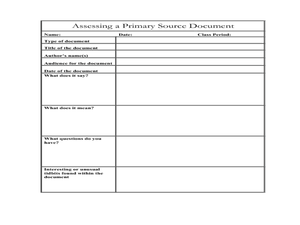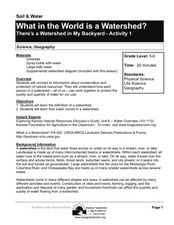Curated OER
The Kansas-Nebraska Act of 1854: Popular Sovereignty and the Political Polarization over Slavery
Why did Stephen Douglas support the Kansas-Nebraska Act of 1854? Why did Abraham Lincoln oppose it? Young historians examine how the Kansas-Nebraska Act of 1854 affected the political balance between free and slave states and explore how...
Curated OER
Sectionalism and the Kansas-Nebraska Act
Students define and discuss sectionalism and popular sovereignty, analyze impact of popular sovereignty in creation of state of Kansas, compare issues in territorial Kansas to current politically divisive topic, and evaluate primary...
Curated OER
The People of Kansas: Where did they come from and why did they come?
Students review census data to correlate to emigration in Kansas. In this Westward Expansion lesson, students analyze a painting and create definitions for emigration and discuss why people emigrate. Students read and analyze 1855 census...
Curated OER
The People of Kansas: Who Are They and Why Are They Here?
Students examine the settlement patterns of the Kansas Territory. In this Kansas history lesson, students analyze primary documents from the pioneers in the territory. Students write letters or perform skits that feature their findings.
Curated OER
The People of Kansas: Where Did They Come From and Why Did They Come?
Students research and discuss the reasons why early settlers emigrated to Kansas. They, in groups, analyze census district reports from the 1850's and then identify the advantages and disadvantages of using this information as research.
Curated OER
Sectionalism, Popular Sovereignty and Secession
Learners read and discuss background material on several key decisions that played a role in the Civil War including the Missouri Compromise, the Kansas-Nebraska Act and the Dredd Scott Decision. They create a timeline and write an essay.
Curated OER
Rights and the Wyandotte Constitution
Every state uses a set of rights to establish laws and regulations. Explore the Wyandotte Constitution as it was written in 1859 and compare it with how rights in Kansas have changed, especially those that pertain to gender and race. A...
Curated OER
Kansas City History
Students conduct research and present a part of Kansas City history to the class. They develop questions and ideas to initiate and refine research. They use technological tools and other resources to locate, select and organize information.
Curated OER
Evolving Views about Minority Rights in the United States
Tenth graders compare and contrast majority and minority outlooks on issues. In this social justice lesson, 10th graders research majority and minority values regarding the Salem Witch Trials, Plessy v. Ferguson, the McCarthy hearings,...
Bismarck Public Schools
Jefferson & the Louisiana Purchase
After learning about the Louisiana Purchase, assess your class members' understanding of Napoleon Bonaparte's involvement, states included in the purchase, and important key terms (i.e. neutrality, corps of discovery, etc.) associated...
American Battlefield Trust
Pre-1861: Disunion
Nat Turner, John Brown, and Abraham Lincoln all played a key role in the run-up to the bloody American Civil War. Using a PowerPoint, timeline activity, and essay prompt, young historians consider the roles of these men and more to...
Curated OER
Rights and the Wyandotte Constitution
Young scholars use graphic organizers to analyze the Wyandotte Constitution. They read and discuss the Wyandotte Constitution, identify the civil rights granted to the people of Kansas and consider exceptions based on gender and race.
Judicial Learning Center
Civil Rights and Equal Protection
Almost every American is familiar with the Supreme Court case of Brown vs. Board of Education. Far fewer understand the constitutional reasoning or the wide-ranging consequences of the ruling in the field of criminology. The interesting...
Curated OER
Town Development
Students evaluate how the impact of building of towns affected slavery. In this United States History lesson, students work in small groups to construct a map, then they participate in a role-playing activity.
Curated OER
Indian Removal to the Great American Desert
Seventh graders examine American policies to relocate Native Americans. In this Native American history lesson, 7th graders determine why Native Americans were relocated and investigate their response to the policies as they analyze...
Hawaiʻi State Department of Education
Dance Critic
What do writing and dance have in common? They both have a six-trait rubric for assessment. Just like a good story, a good dance must have a hook, beginning, middle, end, logical sequence, and a climax. Learners use a...
Curated OER
Dear Wife and Children Everyone
Students study the issue of slave vs. free states. They explore the actions and personal commitment of John Brown and write a newspaper article about the Battle of Osawatomie from John Brown's perspective.
Curated OER
Give Me a Clue!
Young scholars write clue cards for learning the names and locations of each river basin in Kansas using their knowledge of cardinal and intermediate directions.
Curated OER
This Guilty Land
Pupils read and discuss several informational cards about John Brown, the historical context he lived in and his abolitionist cause. They complete a character chart and write an epitaph that conveys their opinion of his actions.
Curated OER
Sandwich in the Water
Students research lakes of eastern Kansas. Students compile their information into a "sandwich" with each layer containing a specific list of information.
Curated OER
Popular Sovereignty and the Lecompton Constitution
Students review the Kansas-Nebraska Act and the development of the Kansas territory Constitution. They complete a cause and effect worksheet and discuss the history of the Lecompton Constitution.
Curated OER
This Guilty Land
Students investigate the actions and motives of John Brown. In this abolition lesson, students discover details about Brown's background as a free-state and abolition supporter. Students discuss his role as that of a martyr or terrorist....
Curated OER
What in the World Is a Watershed?
Learners discover the role of a watershed. In this geography lesson, students are shown a diagram of a watershed and discuss the definition of a watershed. Learners demonstrate the role of a watershed by using an umbrella and spraying it...
Curated OER
Westward Expansion
In this westward expansion worksheet, students read and assess comprehension. In this short answer, matching, and timeline worksheet, students write answers to twenty-five questions.

























